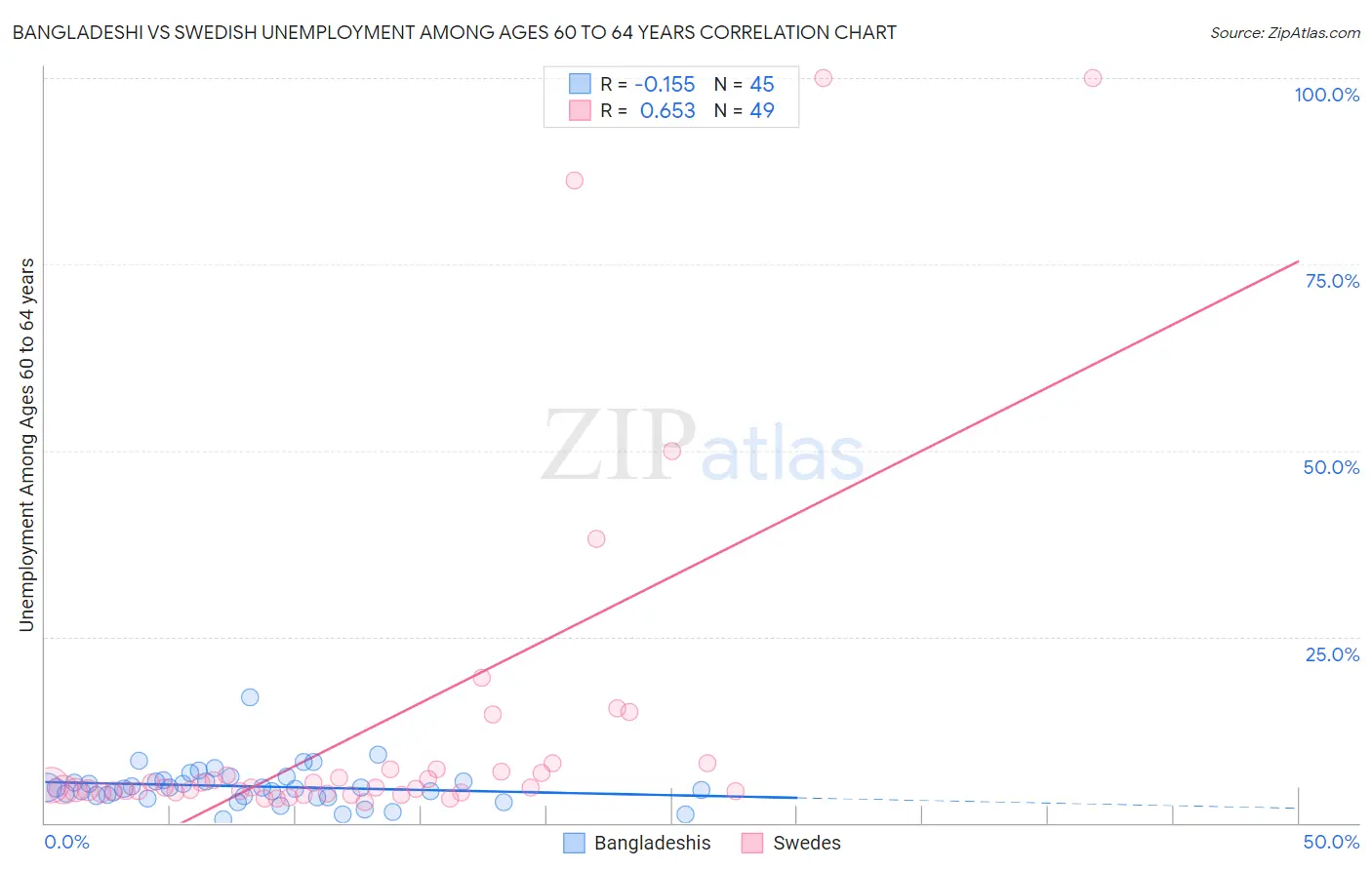Bangladeshi vs Swedish Unemployment Among Ages 60 to 64 years
COMPARE
Bangladeshi
Swedish
Unemployment Among Ages 60 to 64 years
Unemployment Among Ages 60 to 64 years Comparison
Bangladeshis
Swedes
4.6%
UNEMPLOYMENT AMONG AGES 60 TO 64 YEARS
99.9/ 100
METRIC RATING
55th/ 347
METRIC RANK
4.5%
UNEMPLOYMENT AMONG AGES 60 TO 64 YEARS
100.0/ 100
METRIC RATING
43rd/ 347
METRIC RANK
Bangladeshi vs Swedish Unemployment Among Ages 60 to 64 years Correlation Chart
The statistical analysis conducted on geographies consisting of 134,609,028 people shows a poor negative correlation between the proportion of Bangladeshis and unemployment rate among population between the ages 60 and 64 in the United States with a correlation coefficient (R) of -0.155 and weighted average of 4.6%. Similarly, the statistical analysis conducted on geographies consisting of 448,314,180 people shows a significant positive correlation between the proportion of Swedes and unemployment rate among population between the ages 60 and 64 in the United States with a correlation coefficient (R) of 0.653 and weighted average of 4.5%, a difference of 1.1%.

Unemployment Among Ages 60 to 64 years Correlation Summary
| Measurement | Bangladeshi | Swedish |
| Minimum | 0.50% | 2.8% |
| Maximum | 16.9% | 100.0% |
| Range | 16.4% | 97.2% |
| Mean | 4.9% | 13.0% |
| Median | 4.7% | 4.8% |
| Interquartile 25% (IQ1) | 3.5% | 4.2% |
| Interquartile 75% (IQ3) | 5.7% | 7.2% |
| Interquartile Range (IQR) | 2.2% | 3.0% |
| Standard Deviation (Sample) | 2.7% | 22.9% |
| Standard Deviation (Population) | 2.7% | 22.7% |
Demographics Similar to Bangladeshis and Swedes by Unemployment Among Ages 60 to 64 years
In terms of unemployment among ages 60 to 64 years, the demographic groups most similar to Bangladeshis are Dutch (4.6%, a difference of 0.020%), Immigrants from Moldova (4.6%, a difference of 0.050%), Welsh (4.6%, a difference of 0.090%), British (4.6%, a difference of 0.10%), and Kenyan (4.6%, a difference of 0.16%). Similarly, the demographic groups most similar to Swedes are European (4.5%, a difference of 0.060%), English (4.5%, a difference of 0.17%), Immigrants from Sudan (4.5%, a difference of 0.22%), Liberian (4.5%, a difference of 0.29%), and Scandinavian (4.5%, a difference of 0.35%).
| Demographics | Rating | Rank | Unemployment Among Ages 60 to 64 years |
| Iraqis | 100.0 /100 | #39 | Exceptional 4.5% |
| Scandinavians | 100.0 /100 | #40 | Exceptional 4.5% |
| Immigrants | Sudan | 100.0 /100 | #41 | Exceptional 4.5% |
| English | 100.0 /100 | #42 | Exceptional 4.5% |
| Swedes | 100.0 /100 | #43 | Exceptional 4.5% |
| Europeans | 100.0 /100 | #44 | Exceptional 4.5% |
| Liberians | 99.9 /100 | #45 | Exceptional 4.5% |
| Bhutanese | 99.9 /100 | #46 | Exceptional 4.5% |
| Assyrians/Chaldeans/Syriacs | 99.9 /100 | #47 | Exceptional 4.5% |
| Immigrants | Zimbabwe | 99.9 /100 | #48 | Exceptional 4.6% |
| Scotch-Irish | 99.9 /100 | #49 | Exceptional 4.6% |
| Scottish | 99.9 /100 | #50 | Exceptional 4.6% |
| Immigrants | Kenya | 99.9 /100 | #51 | Exceptional 4.6% |
| Kenyans | 99.9 /100 | #52 | Exceptional 4.6% |
| Immigrants | Moldova | 99.9 /100 | #53 | Exceptional 4.6% |
| Dutch | 99.9 /100 | #54 | Exceptional 4.6% |
| Bangladeshis | 99.9 /100 | #55 | Exceptional 4.6% |
| Welsh | 99.9 /100 | #56 | Exceptional 4.6% |
| British | 99.9 /100 | #57 | Exceptional 4.6% |
| Immigrants | India | 99.8 /100 | #58 | Exceptional 4.6% |
| Swiss | 99.8 /100 | #59 | Exceptional 4.6% |